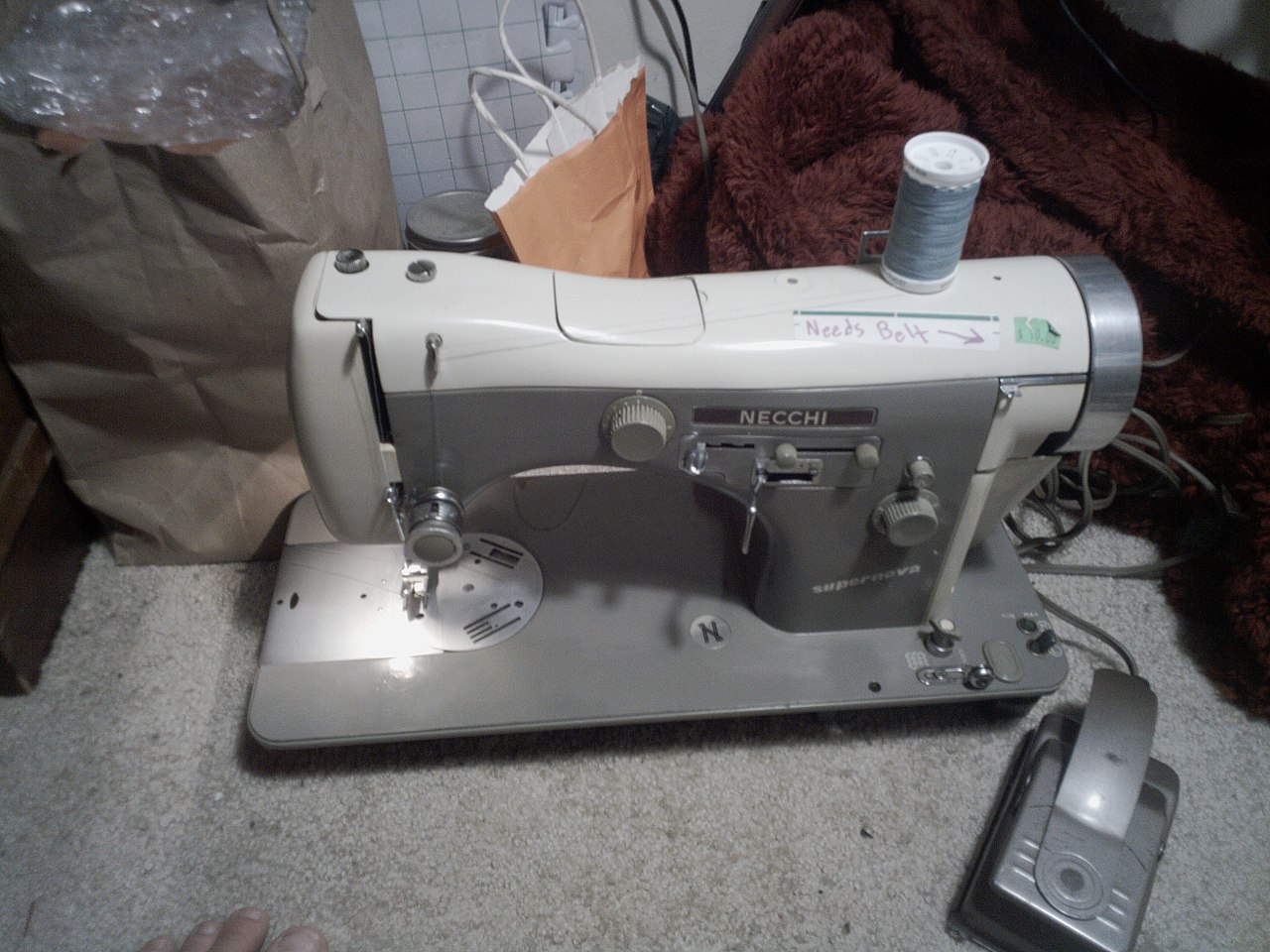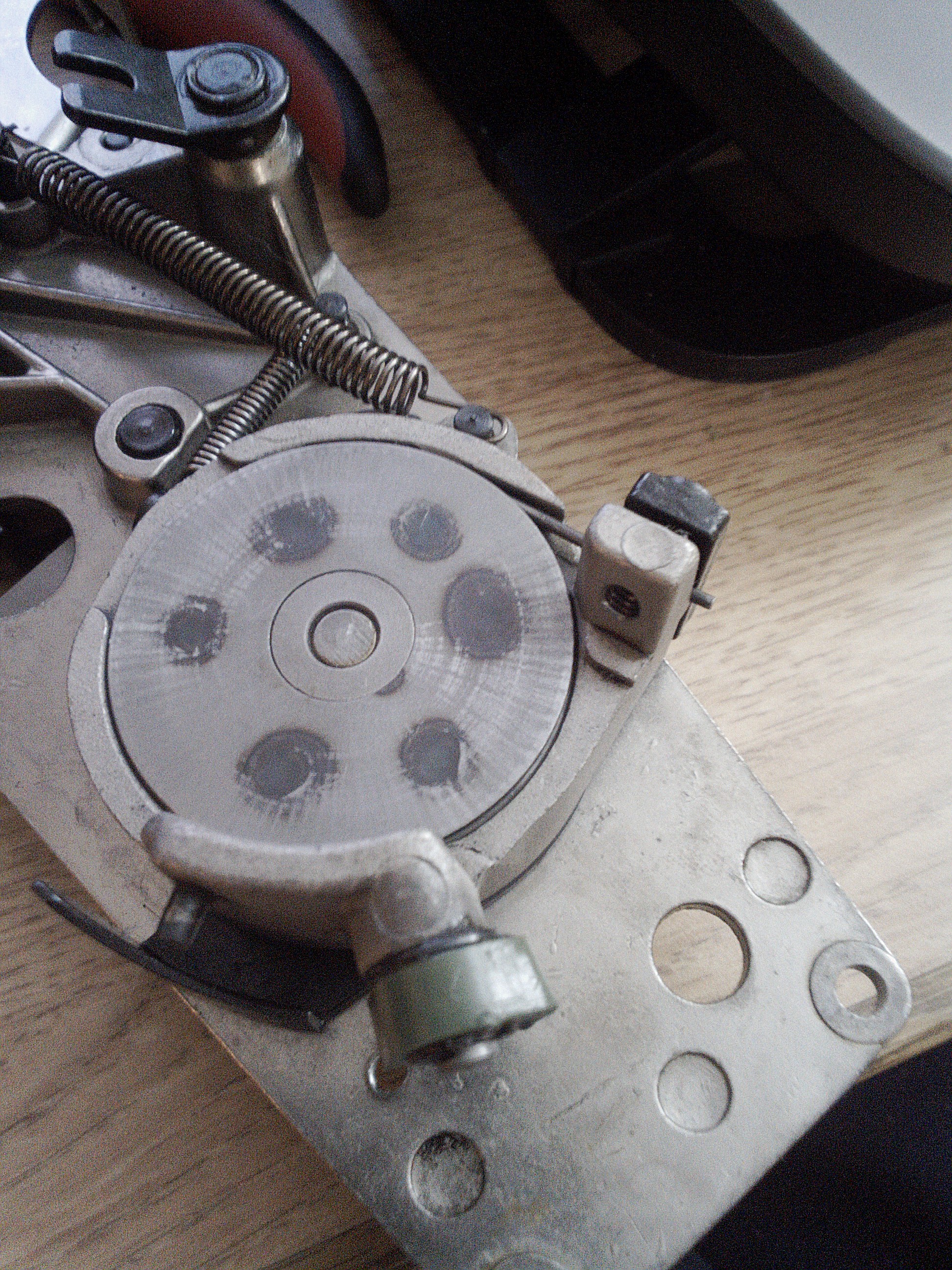Restoring a Necchi Supernova Automatica
Ever since I found a Necchi BU Mira by the dumpster outside my apartment, I've been a bit of an admirer of these well-built Italian sewing machines. So when I spotted a Necchi Supernova Automatica for $10 at The Scrap Exchange, I excitedly picked it up (then quickly put it down in a cart, as it's very heavy). It needed a new belt and bobbin winder thread tensioner, both of which I happened to have on hand from the Mira. The belts for the two machines are a different length, but I had a slightly loose rubber belt for the Mira that fit the Supernova well. After replacing the missing parts, borrowing a bobbin casing, and inspecting the wiring to make sure it was safe to plug in, I found the machine still stitches like a dream.

The Embroidery Unit
Functionally, the Supernova is pretty similar to the Mira, both being high-shank zigzag machines from the same company, released only a few years apart. However, the Supernova Automatica shines in its ability to do automatic embroidery using a stack of cams that individually control the feed, zigzag width, and needle position. While the Mira has an embroidery unit called the Wonder Wheel, this uses only a single cam for both the needle position and zigzag width, and can't control the feed at all, making it far more limited.
The embroidery unit on my machine seemed to be working fine. When I turned the knob to “1”, I could see the shaft stepping around 30 steps per revolution as it's supposed to. So I eagerly ordered an accessory box off Ebay, including almost two full sets of cams, and the missing bobbin casing. The box arrived in good shape, and I quickly put some cams in the embroidery unit to give it a test. It seemed halfway-well calibrated, so I tried another cam stack. But then, disaster struck!
The cam stack I had just installed was stuck on the shaft. I couldn't pull it off, and I didn't want to pry too hard for fear of breaking a cam (they're plastic from the 1950s, after all). So I wondered if running the machine would unstick it, since it seemed to step with a good amount of force. I ran the machine for a few stitches, and watched in dismay as the cams didn't turn, and something inside the machine went snap!
Repairing the Embroidery Unit
It took me a bit to work up the nerve to disassemble the embroidery unit, but it really isn't too complex of a mechanism. Four screws hold it in place, then it just lifts out the top of the machine. And in a stroke of luck, the thing that went snap wasn't anything breaking, but just a spring slipping out of a little plate that holds its end in place. So I put it back in place, reassembled everything, mounted the unit, and tried running the machine. The mechanism stepped like it should, except it only went really fast, without adjustment.
So I tried again. This time, the mechanism didn't step at all. I was worried until I got it to step really fast again, at which point I realized it must be something I'm doing wrong. Service manuals for the machine are readily available online, but reading the section on the embroidery unit didn't get me to success. I must've reassembled that thing a couple of dozen times trying to get it to work, until finally I found the key.
The manual doesn't say this in text, but it's shown in multiple figures. The spring that had slipped out of place needs to actually stick out past the plate a little bit. It naturally tries to sit with its end in the middle of the plate, so I hadn't tried this in any of my assembly attempts. So I made one more attempt with about 1 mm of stick-out, and it almost worked! I couldn't calibrate the unit's stepping properly still, but it was at least adjustable with the knob on the machine's front. So I tried again with about 2 mm of stick-out, and this time it worked!

My Disappointment with the Embroidery Unit
Unfortunately, the '50s design of the embroidery unit has a major limitation: being a clutch drive, it doesn't step an exact integer number of steps per revolution, so utility stitches aren't really possible. It can do artistic stitches very reliably, but things I really want like blind hem and overcast stitches just aren't within the machine's capabilities. So what's a gal to do?
Well, a gal realizes that it's now the '20s, and embedded controllers are pretty easy to get running these days. The machine's linkages have extra posts for the embroidery unit to link to, providing me with an API for controlling the machine internally. So by jamming some servos inside, I should be able to make a modern computerized sewing machine with vintage build quality. The best of both worlds? Stay tuned.
⁓Clara